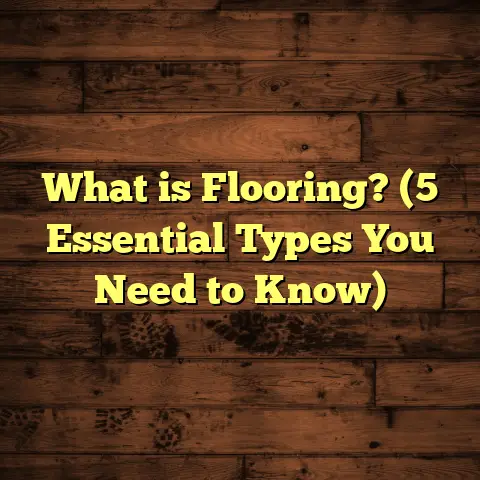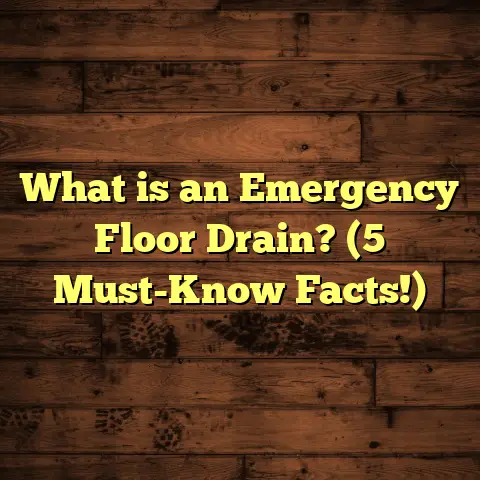What is This Beast on My Floor? (5 Signs It’s a Pest)
Did you know that over 20 million homes in the U.S. face pest problems every year? That’s a huge number, and it shows just how common it is to find creepy crawlies or even bigger critters invading our living spaces. I’ve been working as a flooring contractor for more than a decade now, and throughout my career, I’ve seen firsthand how pests can wreak havoc on floors—and on homeowners’ peace of mind.
If you’ve ever spotted a strange bug or noticed unexplained damage on your floor, you might be wondering: What exactly is this beast? Is it just an annoying insect, or is it the start of a serious pest problem? I’m here to walk you through the signs that what you’re dealing with is indeed a pest—and what that means for your home.
What Is That Creature on My Floor?
When I say “beast,” I’m referring to any pest—living creatures that invade your home and cause harm or discomfort. These could be insects like termites, ants, cockroaches, silverfish, or larger critters such as rodents and spiders. Pests vary widely in size and behavior, but what they have in common is that they can damage your flooring or pose health risks.
Pests don’t just appear out of nowhere; they often come into your home looking for food, shelter, or moisture. Floors are especially attractive because they often have cracks and gaps where pests can hide. Plus, many flooring materials like wood are delicious to termites and carpenter ants. Vinyl edges might be gnawed by mice looking for nesting material. Even carpet fibers can attract beetles or fleas.
Understanding what these creatures are and how they behave is the first step to dealing with them effectively. Let me share some insights based on my experience and research.
Different Types of Pests You Might Find on Your Floor
- Termites: These tiny insects feed on wood and can silently destroy hardwood floors, subfloors, and supporting structures.
- Carpenter Ants: Similar to termites in their wood-boring habits but don’t eat wood; instead, they tunnel inside it to create nests.
- Rodents (Mice and Rats): They chew through almost anything—including flooring edges—and leave droppings and urine.
- Cockroaches: These pests like dark, moist places such as under kitchen cabinets or tiles. They spread germs.
- Silverfish: Small, silver-gray insects that thrive in damp environments and can damage paper, wallpaper, and carpets.
- Fleas and Carpet Beetles: Often found in carpeted areas, these pests feed on natural fibers and can cause itching and allergies.
Each pest has its own habits and preferences. Knowing which one you’re dealing with makes a big difference in how you treat the problem.
Why Floors Are Vulnerable
Floors are often overlooked when it comes to pest control. People tend to focus on walls or kitchen cabinets, but floors provide easy access points:
- Cracks between floorboards
- Gaps where flooring meets walls
- Areas under rugs or carpets
- Moist areas under sinks or near leaks
The materials used also matter. Wood provides food for termites and ants. Carpets give hiding spots for fleas and beetles. Tiles with grout lines can trap moisture inviting ants or cockroaches.
From my experience, the key to preventing pest problems starts with knowing where pests like to hide on your floor and checking those spots regularly.
5 Signs That “Beast” on Your Floor Is Actually a Pest
Let’s get into the nitty-gritty. How do you know if that creepy thing you saw is just a one-off bug or part of a bigger infestation? Over the years, I’ve learned to spot the warning signs quickly.
1. Strange Droppings and Debris
One of the most telling signs of a pest problem is droppings or waste left behind. It isn’t pleasant to talk about, but it’s one of the clearest clues.
- Rodent Droppings: Small, black pellets often found near baseboards or food storage areas.
- Cockroach Droppings: Tiny black specks that look like ground pepper.
- Termite Frass: Sawdust-like piles near wooden floors or furniture.
- Carpet Beetle Cast Skins: Small white skins shed as larvae grow.
In one house I worked on in Atlanta, the homeowner noticed tiny black specks near kitchen corners. She thought it was dirt until she realized it was cockroach droppings. Early detection helped us act fast before the infestation grew.
Droppings tell you not only that pests are present but also give clues about what type they are. For example, termite frass looks different from rodent droppings. Knowing this helps target treatment.
2. Gnaw Marks or Damage to Flooring
Have you noticed strange bite marks or hollow-sounding spots when you tap your floors? This can be a sign of pest damage.
Rodents love gnawing on wood, vinyl edges, and even electrical wires hidden under flooring. Termites and carpenter ants bore tunnels inside wooden floors and subfloors, weakening them over time.
I remember a client whose laminate kitchen floor started bubbling mysteriously. When I lifted a panel, I found termite tunnels beneath! The problem was hidden from view until structural damage caused the floor to warp.
Damage signs include:
- Hollow or soft wood areas
- Bubbling laminate or vinyl
- Scratches or bite marks near edges
- Crumbling wood dust (frass) nearby
If you see any of these signs, it’s time to investigate further.
3. Unusual Sounds Coming From Floors or Walls
Have you heard scratching or scurrying noises coming from underfoot or behind walls? This often signals rodents nesting under floors or larger insects moving about.
One night at my own house, I heard faint scratching near the baseboard. At first, I ignored it, but it kept getting louder. When I checked behind the floorboard, I found carpenter ants had moved in! The sounds disappeared after professional treatment.
Sounds can be subtle but meaningful if you pay attention:
- Scratching = Rodents or carpenter ants
- Buzzing = Flying insects trapped inside walls
- Rustling = Movement of small animals like mice
Ignoring these noises can lead to bigger infestations down the road.
4. Sightings of Live Insects or Rodents
Sometimes pests are bold enough to show themselves during daylight hours.
Ant trails along baseboards or cockroaches running across tiles are common signs. Seeing live rodents scampering across floors at night is another red flag.
One family I helped was frustrated by nightly silverfish sightings in their bathroom. Silverfish love damp environments and can damage wallpaper and fabrics besides floors.
Spotting live pests means the infestation might already be established. Acting quickly is key before they multiply.
5. Musty or Unpleasant Odors
Certain pests produce odors you can smell even if you don’t see them.
Rodents emit a musky scent from urine and fur buildup. Termite-infested wood sometimes smells moldy due to moisture accumulation inside tunnels.
A client of mine once complained of a persistent musty smell in their basement hardwood floor area. It turned out termites were eating away at the subfloor beneath the surface—a problem that would have gone unnoticed without the odor clue.
Smells are subtle but powerful indicators when combined with other signs.
Comparing Pest Detection Methods: What Works Best?
I’ve tried many ways to figure out if someone’s floor has a pest problem—some worked well; others not so much. Here’s a breakdown based on my experience:
Visual Inspections: The Tried-and-True Method
Visual checks are the foundation of pest detection. I walk through homes carefully looking for:
- Droppings and frass
- Floor damage
- Cracks and entry points
- Pest sightings
This method requires experience because not all signs are obvious at first glance. But it’s free and effective when done regularly.
Moisture Meters: Finding Hidden Trouble
Since many pests like termites are attracted to damp wood, moisture meters help detect areas with unusually high moisture content beneath floors.
I used moisture meters in several homes with hardwood floors near basements or bathrooms. High moisture readings often led me to hidden termite damage spots.
This tool is affordable and useful but doesn’t replace visual inspection—it complements it by identifying risk zones.
Infrared Cameras: Seeing Inside Walls and Floors
Infrared cameras detect heat differences behind walls or floors where pests may be active.
I used IR cameras on two projects where homeowners heard noises but saw no physical evidence of pests yet. The cameras revealed warm spots indicating rodent nests behind flooring panels.
Though IR cameras are pricey, they provide non-invasive insights in tricky cases.
Ultrasonic Repellents: Do They Work?
Ultrasonic devices claim to repel rodents by emitting high-frequency sounds humans can’t hear but pests dislike.
I tested these devices in a client’s home with mouse problems. Unfortunately, the mice weren’t bothered much—they kept coming back despite the device running 24/7.
These repellents might help prevent re-infestation but aren’t reliable for controlling existing populations alone.
DIY Pest Control vs. Calling Professionals: My Take
Clients often ask whether they should tackle pest problems themselves or hire experts like me.
Here’s what I usually say:
When DIY Works
For minor problems like occasional ants or silverfish sightings, DIY sprays, baits, and traps can work well—especially if combined with good cleaning habits and sealing entry points.
DIY methods are cheaper upfront but require patience and consistent effort.
When Professionals Are Necessary
For serious infestations involving termites, carpenter ants tunneling inside structural wood, or rodents nesting under floors, professional treatment is crucial.
Professionals have access to stronger chemicals, special baiting systems, fumigation options, and safety training to handle these pests effectively without damaging your flooring further.
One client’s story stands out: after months of trying DIY termite treatments with little success, they finally brought me in for professional help. The targeted treatment eradicated an entire colony hidden deep under hardwood floors—saving them thousands in future repairs.
Prevention Tips That Actually Work for Flooring Areas
Based on my experience working with hundreds of homes, here are prevention steps that really make a difference:
Seal Every Crack and Gap
Pests enter through tiny openings around baseboards, doorframes, and floor edges. Use caulk or weatherstripping to seal these gaps tightly.
Even a small hole invites mice or ants inside!
Control Moisture Levels
Fix leaks promptly under sinks or near bathrooms since moisture attracts termites and cockroaches.
Use dehumidifiers in basements where humidity tends to build up.
Keep Floors Clean
Food crumbs attract ants and cockroaches alike. Sweep regularly and avoid leaving pet food out overnight.
Vacuum carpets often to remove flea eggs and beetle larvae before they hatch.
Choose Pest-Resistant Flooring Materials
If you’re remodeling or building new floors in high-risk areas (like basements), consider vinyl tiles instead of wood since vinyl resists termite damage better.
Treated hardwoods with insect-repellent finishes offer extra protection too.
Regular Inspections
Schedule periodic inspections yourself or through pest control professionals—especially if you live in termite-prone regions like the southern U.S.
Early detection saves money later!
How Pests Affect Different Flooring Types: What You Need to Know
Each type of flooring has different vulnerabilities when it comes to pest damage:
| Flooring Type | Common Pests | Damage Type | Notes |
|---|---|---|---|
| Hardwood | Termites, Carpenter Ants | Structural weakening | Wood is vulnerable; requires quick action |
| Laminate | Rodents | Chewing edges | Damage causes bubbling/warping |
| Vinyl | Rodents | Gnaw marks | Edges vulnerable; surface resistant |
| Tile | Ants | Minimal | Mostly safe; grout cracks invite moisture |
| Carpet | Fleas, Carpet Beetles | Fiber damage | Causes allergies/stains |
Hardwood Floors
Hardwood floors are beautiful but vulnerable if pests invade. Termites silently eat away at subflooring beneath hardwood planks until boards become weak or hollow-sounding when tapped. Carpenter ants do similar damage by tunneling into wood to nest without eating it—leading to structural issues over time.
If you notice soft spots or debris near hardwood floors combined with musty smells or noises beneath them, call an expert immediately!
Laminate Floors
Laminate flooring isn’t eaten by termites since it’s made mostly from compressed fiberboard with a plastic top layer—but rodents love nibbling laminate edges because they’re softer than real wood.
I’ve seen cases where mice damaged laminate edges so badly that panels lifted up or bubbled from underneath due to urine damage as well.
Vinyl Floors
Vinyl flooring itself resists most pest damage but edges and seams where vinyl meets walls are vulnerable entry points for rodents who seek shelter inside walls behind floors.
Keeping these edges sealed reduces risks significantly.
Tile Floors
Tile is generally pest-resistant since it’s inorganic material—ants may nest in grout cracks if moisture builds up but otherwise tiles stay safe from chewing damage.
Regular grout maintenance keeps tile floors less inviting for pests seeking damp shelters indoors.
Carpeted Floors
Carpets provide hiding spots for fleas and carpet beetles which feed on natural fibers causing itchy bites and allergy issues for residents over time.
Vacuuming regularly combined with pet flea treatments reduces carpet pest populations drastically.
Personal Experience: When My Own Floor Became Infested
Let me tell you about the time my own house had a pest problem under the hardwood floor that taught me lessons I still share with clients today:
I heard strange scratching noises late at night around baseboards near my living room hardwood floor. At first, I thought maybe it was my imagination—or perhaps my cat chasing shadows—but the sounds persisted for weeks.
When I finally pulled up a loose floorboard near the corner, I discovered carpenter ants nesting inside! The colony wasn’t huge yet but had already hollowed out some wood underneath where I never expected them to be so active.
I had my trusted pest control team treat the infestation professionally while I repaired damaged sections myself using treated wood patches and sealant afterward.
This experience reinforced how important early detection is—and how pests love hiding where you least expect them: beneath your very own floors!
Case Studies: Real Homes Affected by Floor Pests
Case Study 1: Termites in Atlanta Hardwood Floor
A homeowner contacted me after noticing tiny piles of sawdust-like material near their living room floorboards combined with a faint musty smell. Using moisture meters confirmed dampness under the floor caused by a slow leak from plumbing pipes nearby—a perfect environment for termites.
We arranged termite bait stations strategically around the house perimeter along with localized chemical treatments under floors. After six months of monitoring with follow-up inspections every quarter, the infestation was fully controlled without needing costly full-floor replacement.
Case Study 2: Rodent Damage in Michigan Laminate Kitchen Floor
An elderly couple called me worried about bubbling laminate panels around their kitchen edges accompanied by occasional faint scratching sounds at night. Visual inspection revealed mouse droppings inside cabinet toe kicks plus chew marks along laminate panel edges.
Professional rodent traps were installed along with sealing all visible gaps under cabinets and along baseboards. The couple also replaced damaged laminate panels themselves after confirming rodent activity stopped following treatment efforts over two months.
Data Points That Highlight Pest Impact on Flooring
- According to the National Pest Management Association (NPMA), termites cause over $5 billion worth of property damage annually in the U.S., much of which affects flooring structures.
- Studies show that homes with untreated termite infestations experience an average 20%-30% reduction in property value due to structural damage.
- CDC data reports over 21 million Americans suffer allergic reactions caused by carpet pests such as dust mites and carpet beetles each year.
- Rodents contaminate roughly 20% of global food supplies annually—damage that frequently starts with gnawing around kitchen floors.
These statistics prove how important it is not just for aesthetics but also for health and investment protection that we recognize early signs of pests on our floors and act promptly.
What To Do If You Suspect Your Floor Has a Pest Problem
Here’s my practical checklist based on years of hands-on work:
- Inspect: Look carefully around baseboards, under rugs/carpets, near plumbing fixtures for droppings/damage/sounds.
- Clean: Sweep/vacuum thoroughly removing food crumbs that attract pests.
- Seal: Use caulk/weatherstripping to close entry points along flooring edges.
- Control Moisture: Fix leaks; use dehumidifiers especially in basements/bathrooms.
- Try Traps: For minor insect/rodent problems set bait stations/traps.
- Call Professionals: For suspected termites/carpenter ants/large infestations contact licensed pest control experts immediately.
- Repair Damage: Replace damaged flooring components promptly once pests are eradicated.
- Schedule Regular Inspections: Either DIY checks quarterly or professional inspections annually for peace of mind.
Have you ever found something weird crawling around your floor? Maybe you ignored it at first—but then those subtle signs started adding up? Knowing what “beast” lurks beneath your feet can save you headaches (and money) down the line. Feel free to share your stories—I’m always interested in hearing how others deal with these uninvited guests!





